Authored by Insook Ahn*,
Abstract
Active seniors have not been the priority target market for retailers and apparel companies in the past. Yet, they present an opportunity: the silver population is projected to drive 45%-60% of the consumption growth in major countries in the next 15 years. Therefore, the purpose of this study is to develop safari jacket designs targeting active senior women. Four research objectives were as follows: (a) identify what items active senior women wear the most as casualwear and the reasons for choice by in-depth interview; (b) conduct a street photography survey in seven locations in Seoul, Korea by taking photos of active senior women wearing safari jackets to verify the results of the first in-depth interview; (c) find the material of the safari jacket to develop the safari jacket design by a second in-depth interview; and (d) derive a total of nine safari jacket designs utilizing the gathered data. With the results of this study, we developed and proposed three different styles of Safari jackets to meet the needs of the senior women in Korean market. More importantly, this study gives an insight to international brands who are trying to penetrate Korean market but previously failed to consider Korean active senior market’s unique characteristics.
Keywords:Active senior; Safari jacket design; Product development
Introduction
Advanced technology, healthcare system, effective treatment, and economic growth have led to an increase of life expectancy, with a global average life expectancy of 72.6 years in 2019 [1]. The silver population, people over the age of 65 and older, accounted for 8% of the world population in 2015 and will account for more than a third of total population by 2023. In particular, the silver population will account for more than 20% of the total Korean population by 2035 and drive 60% of its consumption growth.
New terminologies such as “silver boomer, new senior, urban granny, and active senior” have been used in recent years to refer silver consumers who show different consumption patterns and lifestyles. Unlike the elderly in the past, silver consumers enjoy various hobbies and leisure life based on economic margins and actively participate in social activities. In particular, active seniors are considered as the untapped market of the silver industry [2- 4]. Accordingly, the demand for products related to health and medical services, travel, leisure, housing management, home services, and cultural life is also increasing. In addition, active seniors believe themselves younger than their actual age, and they pursue ‘extroverted youth’ lifestyle by investing in fashion as well as physical health and paying attention to social trends [5].
Active seniors have not been the priority target market for retailers in the past. Yet, they present an opportunity: the silver population is projected to drive 45%-60% of the consumption growth in major countries in the next 15 years [6]. According to the wholesale market analysis data by Lee [7], new brands targeting seniors in their 50s and older increased, including women’s wear that shifted the focus from missy casuals for housewives in their 30s and 40s to seniors who are 50s or older. In addition, the revenues from seniors in their 60s or older in department stores have been increasing for years in Korean apparel market. This suggests the importance and profitability of active seniors in the fashion industry and the need for research on them.
Previous studies report that elderly women prefer a combination of slacks with a jacket that combines functionality and fashion elegance [8]. Even though safari jacket is a more popular wear for travel, leisure, and social activities than regular jackets, most studies on the outerwear of elderly women have been conducted on suits and jackets [9]. There are only a few studies related to safari jackets [10,11]. However, no research has been done on developing safari jacket designs that are preferred by active senior women. Therefore, the purpose of this study is to analyze currently available safari jacket designs and present a new jacket design that satisfies the active senior lifestyle and their consumption needs.
This study combines literature review and empirical studies. In the literature review, domestic and foreign research articles, newspaper articles and fashion magazines, and online data were analyzed to understand active seniors’ lifestyle and their preferences. For the empirical study, we first identified active seniors’ key preferences by conducting and analyzing the in-depth interviews of ten active senior consumers aged 55 and older. Next, we followed up the interviews by taking photos of various active seniors wearing safari jackets in seven different locations in Seoul, Korea. The characteristics of the safari jackets worn by these seniors were recorded for analysis. A second in-depth interview with five brand store managers and fabric designers was conducted in order to identify appropriate materials for developing safari jacket design. Finally, utilizing the gathered data, we produced three safari jacket designs.
This study took active senior consumers’ point of view when planning and developing the design. This market-oriented planning method is different from the theoretical seasonal planning method in that it takes the present market trend analysis data to reflect the present fashion market and current industry practices. This study contributes to the development of the fashion market and gives recommendations to international brands who are planning to penetrate the Korean active senior apparel market by demonstrating that market-oriented planning method is helpful in understanding the local market.
Active senior
Active seniors are distinct from the “silver generation” in that they actively consume and engage in social and cultural activities. According to the Statistics Korea [12], the proportion of people over 50 years old (51%) is projected to surpass the proportion of people under 50 years old (49%) in 2035 and it is predicted that the number of people over 50 years old will be 26.4 million. It is said that the middle-aged consumers, aged 50 to 64, pursue an active lifestyle based on economic power and health, and have a high consumption level [13,14]. They enjoy various activities such as learning foreign language, computer education, beauty, and sports, and are emerging as a new consumer class in a stagnant cultural market such as travel and performance [15].
The characteristics of the active senior are as follows. First, active seniors are younger and have higher incomes than the older silver generations. Active seniors’ income in 2016 was 4.2 percent higher than in 2006, which can be seen as the power of baby boomers who majorly contributed to Korea’s economic growth [16]. With the increased income, their overall consumption spending has increased as well, such as on leisure (increased by 57%), education (increased by 136%), and insurance (increased by 40%). Second, active seniors’ lifestyle is based on stable assets, high interest in fashion, and self-management. Consumers in their 50s prefer consumer goods that are personalized and differentiated to show their social status. On the other hand, consumers in their 60s prefer simple and minimalistic products or services and appreciate practicality [17]. Third, active seniors pursue a lifestyle of the younger generation unlike the silver generation. Health and selfcare are considered as essential, as well as achieving wellness, such as a willingness to live actively and positively, a sense of interest in new things, curiosity, and a flexible attitude to enjoying life. Finally, active seniors often engage in leisure and cultural activities and are fashion-conscious [18]. This overturns the image of the senior generation being insensitive to new things and old-fashioned. Active senior generation communicates with the present without losing their youthful sense and seek to create their own unique identity through fashion.
Active seniors’ typical outfits
Older generation has their own typical styles, which are considered “Grandpa or Grandma-like.” With the active seniors, however, are rejecting this old style and actively creating their own youthful style [19]. This means that active seniors who create new lifestyles are forming a new fashion trend and culture that is different from their predecessors. Instead of dressing modestly or conservatively, active seniors tend to wear luxurious and stylish clothes.
Studies on senior fashion in Korea include body shape characteristics and preferences of seniors, many of which are studies on jackets. Older women in Korea generally prefer a style that allows them to feel comfortable [20]. In addition, women in their 50s, 60s and 70s prefer simple and active styles, elegant and feminine styles, and more youthful-looking styles. For jackets, those in their 50s and 60s preferred tailed collars, set-in sleeves, hip length and plain jackets [21]. More recently, older women in Korea express that they prefer the relaxed style of jackets or coats when going outside for daily activities [22,23]. Specifically, women in their 50s found fashionable design to be the most important factor when choosing their clothes, while women in their 60s emphasized the importance of functionality, preferring a two-piece clothing as an outing wear [24,25].
Safari jacket
The safari jacket belongs to the jacket category and is an activewear with a plenty of arm space. It is widely worn for daily activities, regardless of age or gender, for various purposes. Developed in the 1600s in Britain’s Kirtle, it became the jacket of today’s form. In particular, safari jacket is a lightweight shirt jacket with long sleeves, many pockets, and belts in an easy-to-wear style for hunting or traveling in Africa.
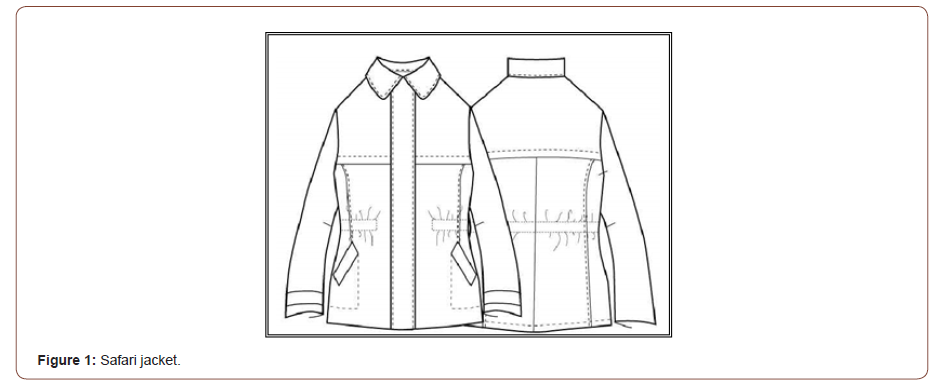
The material of the safari jacket is mostly hemp or thick cotton, which is characterized by its durability. Changing these materials to soft silk, chiffon, and cotton blends is called soft safari. In this study, safari jacket is an application of soft safari to the jacket, which emphasizes practicality in style rather than the original safari, which is for traveling and hunting. In terms of materials and design, it is an on-time concept jacket that is close to semi-suit. It can be seen as a kind of outer wear that is used as a trench coat (Figure 1).
The length of safari jackets can be classified into three sections (long, medium and short) according to the standard used in the active senior brand industry. In this study, the length of the jacket refers to the length from the back neckline to the hem. The long safari jacket is longer than 30 inches (76cm); the middle safari jacket is 28 inches (71cm) to 30 inches (76cm); short safari jacket is shorter than 28 inches (71cm). The collar of the safari jacket has a total of six forms, including wing collar, convertible collar, stand collar, mandarin collar, round neckline, and hooded form. The front closing can be divided into four types: covered placket with hidden zipper, zipper without placket, snaps, and buttons. The type of pockets can be divided into five types: slanted pocket, slanted flap pocket, patch pocket with flap, top-stitched patch pocket and zipper pocket. The waist details can be divided into four types: inner string through inside of the waist tunnel, outside front string through outside of the waist tunnel, self-fabric belt, and one without a belt or string. The details of the cuffs can be divided into western cuff, tab cuff, color combination turn-up cuff, strapped cuff, and shirred cuff. The chest details can be divided into four types: top stitched seam detail, storm flap, no details, and breast pocket. Finally, the shoulder details can be divided into epaulettes and no details.
Empirical Research for Safari Jacket Design Development
In-depth interview for safari jacket design analysis
To find out what items active senior women wear the most for their daily activities, in-depth interviews were conducted for 10 days with five active senior brand store managers, and then with ten active senior female consumers who were over the age of 55. The first in-depth interview was conducted from the active seniors’ point of view and later from the store managers’ point of view in terms of sales and popular items. By the end of interviews, safari jackets were identified as most frequently worn item for daily activities.
The important factors that consumers considered for choosing a safari jacket were “easy to be active,” “easy to wash and care,” “light comfort,” “resolving wrinkle problems,” “cover body’s shortcoming,” “looks younger,” and “wearing up for various gatherings.” These are summarized in the table below in Table 1.
Table 1:Characteristic of the patients with AED withdrawal (n=162).

Street attire survey for safari jacket design analysis
In order to verify the results from the interviews, street surveys were conducted to investigate what these consumers wear by taking photos of people’s outfit. Street attire survey was conducted in seven locations in Seoul, Korea: Entrance to Seodaemun Culture and Sports Center, Entrance to Women’s Sauna in Hongje-dong, Entrance to New Core Gangnam & Outlet Gangseo NC Department Store, Entrance to Lotte Department Store Headquarter, Entrance to Sinchon Branch of Hyundai Department Store, and Entrance to Love Church in Gangnam, where many active senior female consumers frequent in fall. We asked for permission before taking a picture and verified their age on the spot. By the end of the survey, we took 1,232 safari jacket photos for this study. All photos were analyzed to classify the design, detail type, color, length, and collar types. Other six design elements, such as front closing, waist, pocket, sleeve, chest, and shoulder detail classification were also considered. Although details of safari jackets could be classified by type of detail during the study, a follow-up in-depth interview was conducted because the jackets’ material was difficult to identify. The second in-depth interview was conducted with five fabric designers and five store managers working at popular active senior brands to identify the five most commonly used materials for safari jackets.
This study presents the types of safari jacket designs for active senior women and propose new safari jacket designs consisting of 10 design elements, such as color, length, collar shape, front closure detail, waist detail, pocket detail, sleeve detail, chest detail, shoulder detail and material. Our proposed jacket designs are intended to be used as go-to references for safari jacket product development while also satisfying the customers’ needs.
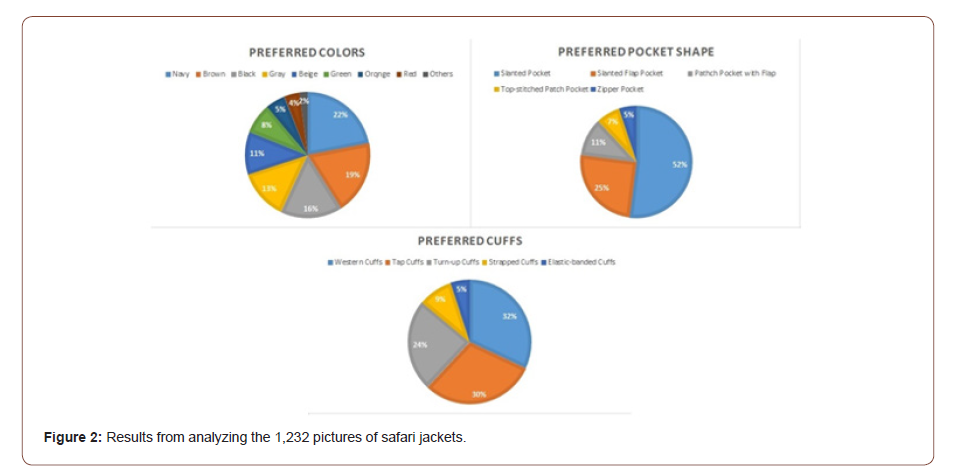
After analyzing the 1,232 pictures of safari jackets (Figure 2), it seemed that 271 participants (22%) preferred navy the most, followed by brown (232 participants, 19%), black (195 participants, 16%), gray (158 participants, 13%), beige (133 participants, 11%), green (104 participants, 8%), orange (59 participants, 5%), and red (51 participants, 4%). The other 29 participants (2%) preferred blue, yellow, pink, or others. These results seem to have been influenced by the fall season, when the outfit survey was conducted. Among the three lengths of the safari jacket, most active senior women preferred the middle length (851 participants, 69%), followed by long length (332 participants, 27%), and short length (49 participants, 4%). In terms of collar, active senior women preferred stand collar the most (530 participants, 43%), followed by hood (335 participants, 27%), convertible collar (189 participants, 15%), and mandarin collar (95 participants, 8%). Others preferred other types of collars, including round neck, frill collar, wing collar, etc. (83 participants, 7%).
Most active senior women preferred slanted pockets (641 participants, 52%), followed by slanted flap pockets (308 participants, 25%), patch pocket with flap (136 participants, 11%), topstitched patch pocket (87 participants, 7%), and zipper pocket (60 participants, 5%). Covered placket with hidden zipper was the most preferred front closing detail (729 participants, 59%), followed by zipper (249 participants, 20%), snap without zipper (159 participants, 13%), and button (95 participants, 8%). In addition, inner string was the most preferred among the four waist detail types (702 participants, 57%), followed by outside string (345 participants, 28%), self-fabric belt (99 participants, 8%), and no detail (86 participants, 7%).
Active senior women also preferred western cuffs the most (394 participants, 32%), followed by tab cuffs (371 participants, 30%), color combination turn-up cuffs (292 participants, 24%), strapped cuffs (111 participants, 9%), and elastic-banded shirred cuffs (64 participants, 5%). They preferred top stitched seam detail the most (392 participants, 32%), followed by storm flap (382 participants, 31%), no details (369 participants, 30%), and breast pocket (89 participants, 7%). A majority of active senior women preferred no epaulettes (998 participants, 81%), compared to the 234 participants (19%) who preferred epaulette detail.
We conducted a second in-depth interview with five fabric designers and five store managers working at popular active senior brands to analyze the preference for safari jacket materials. Five most commonly used materials for jackets were selected, including memory polyester, poly taffeta, Cresed Nylon/Polyester, NC Span, and TR Gabardine.
Safari Jacket Design Development
Design concepts and production procedures
The concept was selected by combining seasonal F/W trend with the results of 10 design elements derived from the first indepth interview, outfit survey, and the second in-depth interview. Then, through target and image positioning, safari jacket design for active senior women was developed by each theme in the following process.
Concept: The concept is inspired from a popular Korean drama. It portrayed a story of an elderly mother and her old friends reminiscing their old days, seeking to find their lost femininity and youthful energy and wanting to seek their own unique identity beyond being a mother and wife. From this, our titled concept, “Dear My Friends,” seeks to portray a joyful, bright, and elegant image by adding lace to safari detail elements to enhance femininity and utilizing color play to show urban sophistication.
Target: The main target market for the design development is women aged between 55 and 65 and the sub target of women aged between 50 to 70 years old, who are seeking to expand from their main identities—mother and wife—to develop their own unique self. These active senior women are interested in becoming the “main character” in their life, rather being sidelined as a “supporting character” to their family. They are highly interested in taking care of their appearance and health, and thus heavily invest in not only fashion, but also in culture, performances, and travel.
Image positioning: Based on the images suitable for the safari jacket design concept, the design was positioned as Elegance, Casual, Chic, and Modern (Figure 3).
Theme segmentation: A Korean trend information company suggested a semi-formal look that are characterized by comfort, utility, and retro mood to be most popular item to be worn in the city center for F/W. This look is characterized by matching simple silhouettes with textured materials, laser cutting, and lace matching to create a vintage romantic mood.
Freedom, personality, evolution, and sophistication were proposed as keywords for the F/W material, and creative interpretation and application of materials can be cited as the development of hybrid material technology and opportunities to create new design. The F/W trend created a new aesthetic value by placing a contrasting texture or color/pattern as a free collage while dismantling and reconstructing the methods of previous generations. The matching and color arrangement of different materials were thought to resemble the life of an active senior who has lived through various experiences and is drawing the second act of life, where they embark on a journey to rediscover themselves. To show the first and second acts of life, two themes are suggested in this study. In other words, to characterize the concept ‘Dear My Friends,’ virtual Muse 1 and 2 were created and separated into THEME 1 (Lace Matching Theme Romantic-Yuppie) for Muse 1 and THEME 2 (Color Play Theme Culture-Cross) for Muse 2.
Muse 1 and Muse 2 are fictional characters that have been created by the researchers to represent each theme. The following are arranged as shown in Table 2 and Table 3.

Table 2:
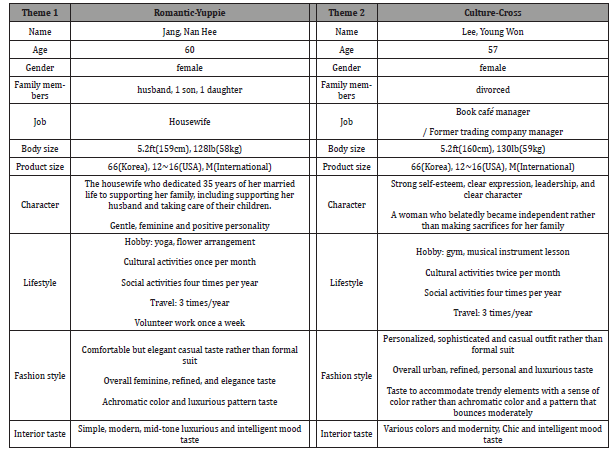
The THEME 1, Romantic-Yuppie, is a lace matching theme that partially matches cotton and poly-blend laces, focusing on designing with elegant sensibility while maximizing femininity. Four safari jacket designs are proposed, which are presented on Table 4, by applying the top-ranked preferences among the 10 design elements derived from the in-depth interviews and outfit research.
Table 3:Design developments for theme 1.
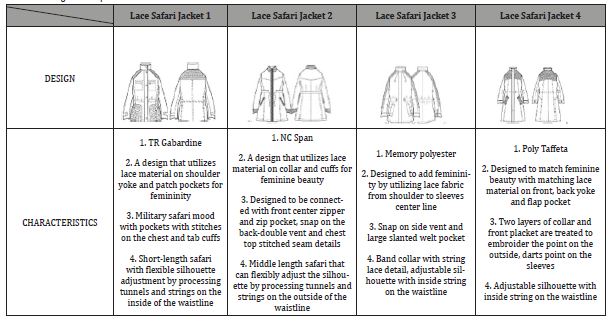
The THEME 2, Culture-Cross, is a color play theme that places different colored materials to emphasize modern and chic taste while addressing urban sensibility. Five safari jacket designs are proposed in Table 5 by applying the top-ranked preference type among the 10 design elements derived from the in-depth interviews and outfit research.
Table 4:Design developments for theme 2.
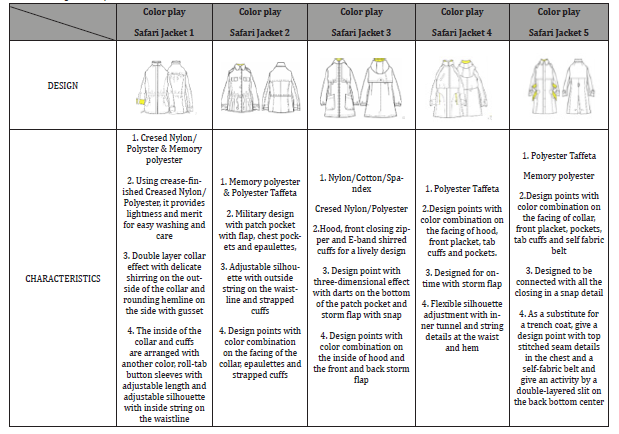
Design production
Out of a total of nine safari jacket designs, three safari jacket styles were produced according to the classification standard of the brand industry common length. In THEME 1, Romantic-Yuppie, a lace-matched middle length safari jacket was produced, and in Theme 2, Culture-Cross, a short safari jacket and a long safari jacket with color matching were produced. Thus, a total of three safari jackets were produced.
The following Table 6 summarizes the photographs of the produced works, product sizes, fabrics, and subsidiary materials.
Table 5:Three examples of developed styles.
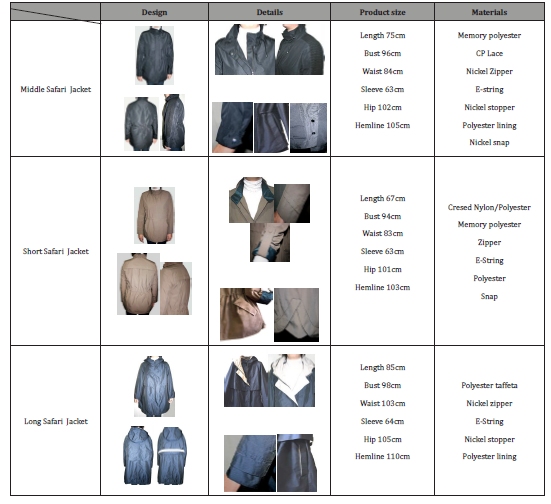
Conclusions
The purpose of this study is to develop safari jacket designs targeting active senior women and to develop designs that satisfy active senior’s lifestyle and consumption needs by conducting a methodological and thorough analysis on their lifestyle and currently available safari jacket designs.
After literature review, we took following steps to develop safari jacket designs as preliminary steps: in-depth interviews with five store managers; determination of preferred design elements for safari jacket; and the analysis of a total of 1,232 street photos, jackets worn by active senior women. The results of this study are as follows:
First, active senior women preferred safari jackets that are comfortable, easy to wash and care, economically efficient, practical, and fashionable while compensating for the shortcomings of body shape. Second, they preferred navy color for their safari jackets, followed by brown, black, gray, beige, green, orange, and red. Third, they preferred middle-length safari jackets the most, followed by long-length and short-length. Fourth, they preferred to wear their jackets by opening the stand collar the most, followed by hood shape, convertible collar, and mandarin collar. Fifth, they preferred the covered placket with hidden zipper the most, followed by zipper without placket, snap without zipper and button closure. Sixth, they preferred the inner tunnel and string in the waist of their safari jackets the most, followed by having the outside string with inner tunnel, belted with outer material and without decoration. Seventh, they preferred slanted pockets the most, followed by slanted flap pockets, patch pockets with flap, patch pockets, and zipper pockets. Eighth, they preferred the western cuffs of safari jackets the most, followed by the tab cuffs, color combination turn-up cuffs, selffabric strapped cuffs and shirred elastic-band cuffs. Ninth, the top stitched seam detail among the different types of chest details of safari jackets was the most preferred, followed by the storm flap without decoration and the breast pocket. Lastly, active senior women overwhelmingly preferred the details without epaulette over epaulette detail.
Reflecting the findings of the two surveys and the outfit photography analysis, seasonal F/W trend was applied to derive a total of nine safari jacket designs for active seniors with lace matching and color play themes. The following three safari jackets were produced. First, a middle length safari jacket was produced by matching the lace with a stand collar design using memory polyester material. Second, a short-length safari jacket was produced using the Cresed Nylon/Polyester material, which was contemporary color-blocked styling on the inside of the stand collar and the inside of the cuffs. Third, long-length safari jacket was produced using poly taffeta material, which was also color-blocked inside the hood, inside the front closing placket, inside tab cuffs and inside the pocket.
The results of this study are significant in terms of analyzing and developing designs from the consumers’ needs and wants. This study contributes to the field by proposing a market-oriented planning method that applies the existing trend analysis data rather than applying the traditional planning method, which is more theoretical and does not appropriately reflect the consumers’ current needs. In addition, this study has a managerial implication in that by helping apparel companies to properly research consumers’ needs, they can increase the sales and awareness of brands that target active seniors, who have a considerable economic power. More specifically, this study gives an insight to international brands who are trying to penetrate Korean market but failing to consider Korean active senior market’s unique characteristics.
This study only focused on safari jackets worn during fall. Further research is needed to design safari jackets for future spring/summer seasons and safari padding jackets for the winter season. These studies will contribute to the currently lacking data for the seasonal planning of brands targeting active senior women.
To read more about this article....Open access Journal of Textile Science & Fashion Technology
Please follow the URL to access more information about this article
To know more about our Journals...Iris Publishers





No comments:
Post a Comment